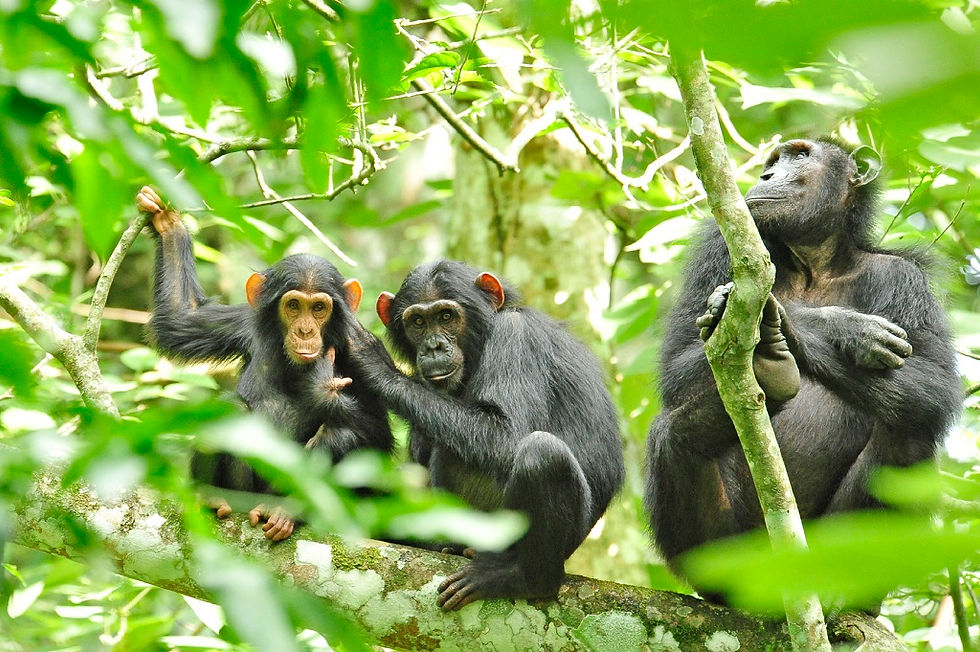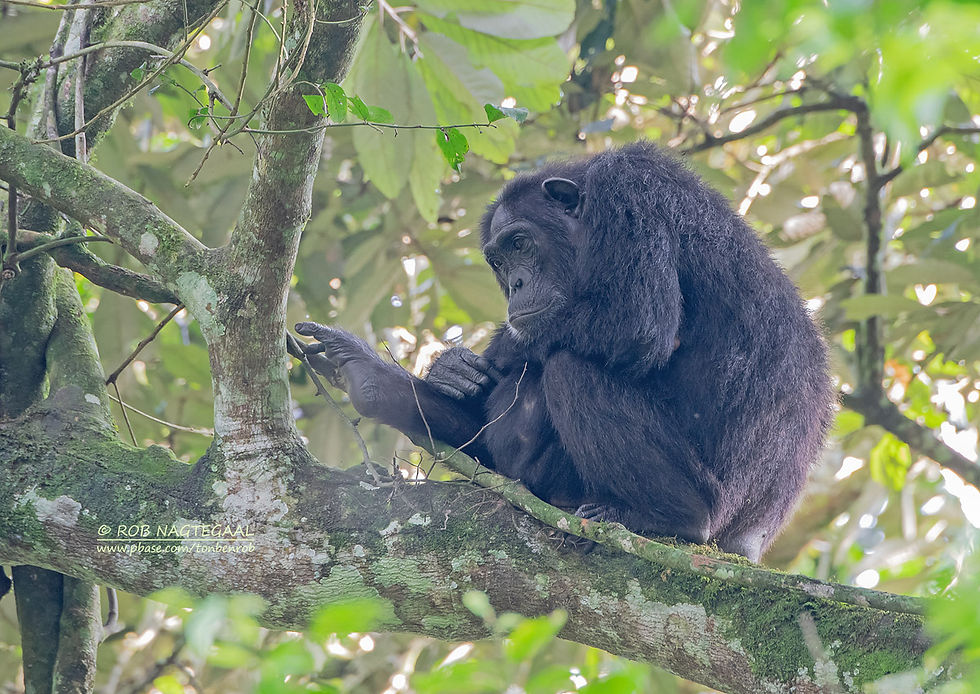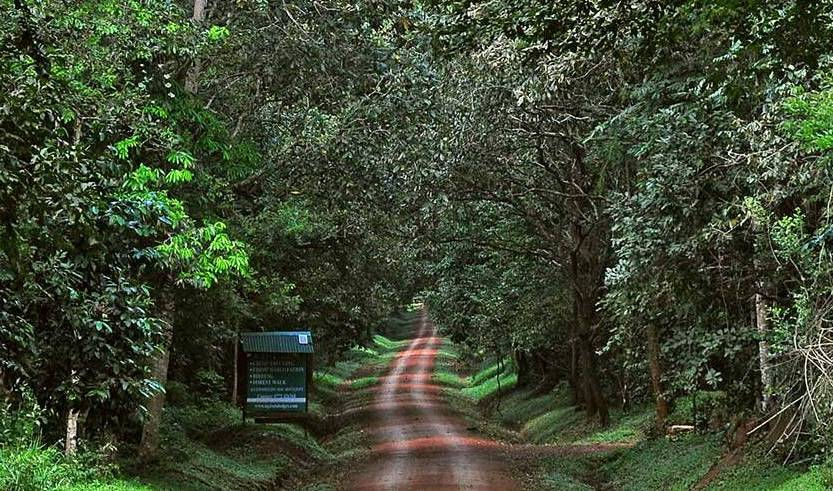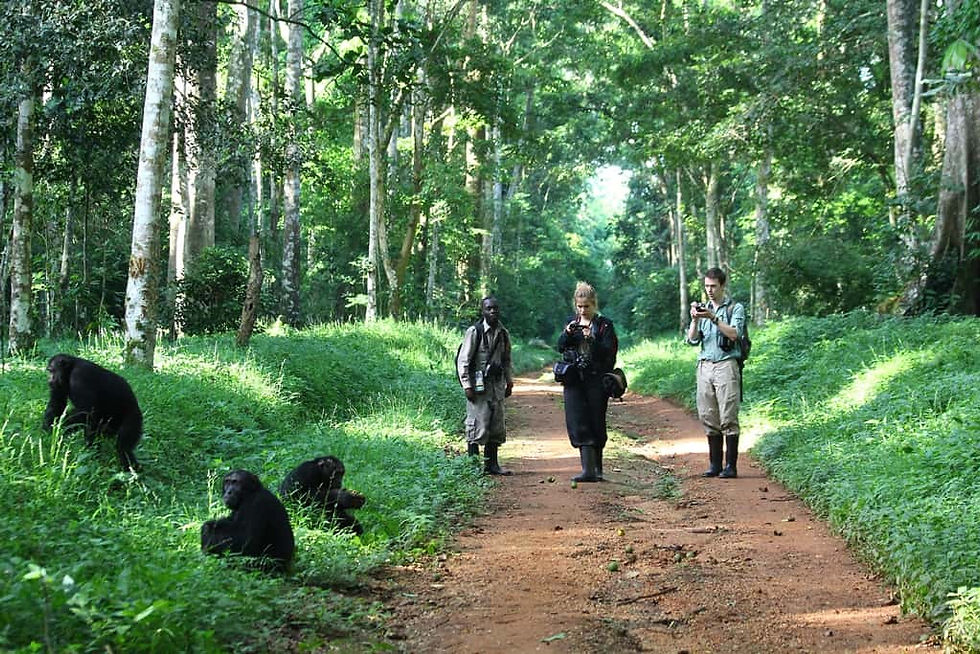
Budongo Forest Reserve
2025 Guide to Budongo
Located in northwestern Uganda, Budongo Forest Reserve is the country’s largest surviving natural forest, spanning 825 square kilometers across Masindi and Buliisa districts. Established in 1932 and managed by the National Forestry Authority (NFA), with ecotourism overseen by the Uganda Wildlife Authority (UWA), Budongo lies within the Murchison Falls Conservation Area, adjacent to Murchison Falls National Park. Renowned for its 600-800 chimpanzees, 24 mammal species, and over 280 bird species, the forest is a premier destination for chimpanzee trekking and birdwatching. Its mahogany-rich tropical rainforest, interspersed with savanna and riverine ecosystems, supports biodiversity research through the Budongo Conservation Field Station (BCFS) at Sonso. Just 3-4 hours’ drive from Kampala, Budongo offers an accessible yet immersive wilderness experience. This guide covers everything you need to plan your visit, from activities and accommodations to dining and conservation efforts.
budongo forest reserve
2025 Guide to Budongo
Located in northwestern Uganda, Budongo Forest Reserve is the country’s largest surviving natural forest, spanning 825 square kilometers across Masindi and Buliisa districts. Established in 1932 and managed by the National Forestry Authority (NFA), with ecotourism overseen by the Uganda Wildlife Authority (UWA), Budongo lies within the Murchison Falls Conservation Area, adjacent to Murchison Falls National Park. Renowned for its 600-800 chimpanzees, 24 mammal species, and over 280 bird species, the forest is a premier destination for chimpanzee trekking and birdwatching. Its mahogany-rich tropical rainforest, interspersed with savanna and riverine ecosystems, supports biodiversity research through the Budongo Conservation Field Station (BCFS) at Sonso. Just 3-4 hours’ drive from Kampala, Budongo offers an accessible yet immersive wilderness experience. This guide covers everything you need to plan your visit, from activities and accommodations to dining and conservation efforts.

BUDONGO's Attractions and Activities
Chimpanzee Trekking
Budongo is one of Uganda’s top destinations for chimpanzee trekking, hosting 600-800 chimpanzees across several communities, with habituated groups at Kaniyo Pabidi and Busingiro. Treks ($130-$200 for non-residents) start at 7:00 AM or 2:00 PM from Kaniyo Pabidi, lasting 2-4 hours with an 80% sighting success rate. Visitors spend one hour observing chimpanzees feeding, grooming, or swinging through the canopy. Other primates, like black-and-white colobus and olive baboons, are often spotted. Treks require participants to be 15+ and free of illness to protect the chimps. Book through UWA or operators like Deks Tours Ltd.
Chimpanzee Habituation Experience
For an in-depth encounter, the Chimpanzee Habituation Experience ($230-$250 for non-residents) allows a full day with researchers, observing chimpanzees from dawn to dusk. Offered at Kaniyo Pabidi, this immersive activity supports BCFS research and offers insights into chimp behavior. Limited to small groups, it requires advance booking (3-6 months) due to high demand. Moderate fitness is needed for the forest terrain.
Bird Watching
Budongo’s 280+ bird species, including forest specialists like the Ituri batis, rufous-crowned eremomela, and yellow-footed flycatcher, make it a birder’s paradise. The Royal Mile, a wide forest track near Nyabyeya Forestry College, is Uganda’s premier birding site, hosting species like the African dwarf kingfisher and chocolate-backed kingfisher. Guided birding tours ($30-$80) from Busingiro or Kaniyo Pabidi are best during wet seasons (March-May, September-November) for migratory birds. BCFS’s revitalized ornithology research enhances sightings.
Guided Nature Walks
Guided nature walks ($20-$50, 2-4 hours) explore Budongo’s mahogany and ironwood forests, revealing 465 plant species and wildlife like bushbucks, duikers, and red-tailed monkeys. Trails like the Royal Mile, Habitant Trail, and Hornbill Trail at Busingiro offer scenic routes, with chances to spot forest elephants or bushpigs. Walks from Kaniyo Pabidi focus on primate habitats, while Sonso trails highlight BCFS research sites. Rangers ensure safety and share ecological insights.
Royal Mile Forest Walk
The Royal Mile, a 1km stretch of pristine forest near Busingiro, is a must-visit for its towering mahogany trees and biodiversity. Named for its historical use by Bunyoro kings, this trail ($20-$40) is ideal for birdwatching, photography, and forest immersion. Guided walks reveal rare birds like the Nahan’s francolin and cultural stories of the forest’s significance. Morning tours maximize wildlife sightings.
Cultural and Community Visits
Engage with the Banyoro and Bagungu communities near Budongo through cultural tours ($10-$30), arranged by local guides or lodges like Budongo Eco Lodge. Visit villages in Masindi to learn about traditional farming, drumming, and storytelling. Community-led ecotourism projects, supported by BCFS and KAFRED, fund schools and conservation, offering authentic experiences like crafting bark cloth or tasting local brews.





.jpg)
How to Get to Budongo Forest Reserve
Budongo is accessible by road or air, often combined with Murchison Falls National Park visits.
-
By Road: From Kampala, the 250km northern route (3-4 hours) via Masindi to Kaniyo Pabidi is tarmacked until the final 20km murram road. The southern route via Hoima (300km, 4-5 hours) connects to Busingiro. From Fort Portal, it’s 150km (2-3 hours) via Kagadi. A 4x4 is recommended for wet seasons. Guided transfers cost $100-$250.
-
By Air: Charter flights from Entebbe to Pakuba or Bugungu Airstrips (Murchison Falls, 1 hour, $200-$400) via Aerolink Uganda, followed by a 1-2 hour drive to Kaniyo Pabidi. Book early for peak seasons.
-
Public Transport: Buses from Kampala to Masindi (UGX 15,000-20,000, $4-$5) take 3-4 hours. Taxis or boda-bodas from Masindi to Kaniyo Pabidi cost UGX 20,000-30,000 ($5-$8). Operators like Prime Uganda Safaris offer group shuttles ($20-$50).
-
Visa Requirements: Uganda visas ($50) are available online or on arrival. The $100 East African Tourist Visa covers Uganda, Rwanda, and Kenya. Carry a yellow fever vaccination certificate.
-
Access Points: Kaniyo Pabidi (main hub, 29km from Masindi) and Busingiro (southern entry, near Nyabyeya) are the primary ecotourism sites, with UWA ranger posts.
BEST TIME TO VISIT
Budongo’s equatorial climate supports year-round visits, with seasonal variations.
-
Dry Seasons (December-February, June-July): Ideal for chimpanzee trekking and walks, with drier trails and abundant wildlife at water sources. June-July is peak season; book 3-6 months ahead. Temperatures average 20-30°C (68-86°F).
-
Wet Seasons (March-May, September-November): Lush forests and excellent birdwatching, with fewer crowds. Trails may be muddy, but chimp sightings remain high. April is wettest (150mm rain). May and December are shoulder seasons.
Park Fees and Permits
Fees, managed by UWA, fund conservation and community projects.
-
Park Entrance: $40/day (non-residents), $30 (residents), UGX 20,000 (~$5) (East Africans).
-
Chimpanzee Trekking: $130-$200 (non-residents), UGX 100,000 (~$27) (East Africans).
-
Chimpanzee Habituation Experience: $230-$250 (non-residents), UGX 150,000 (~$40) (East Africans).
-
Nature Walks/Birding: $20-$80 per person.
-
Camping: $10-$15 per person at UWA sites.
WHERE TO STAY
Budongo offers limited but cozy accommodations, with more options in nearby Masindi.
-
Mid-Range: Budongo Eco Lodge (Kaniyo Pabidi) offers eco-friendly cabins with forest views ($50-$100/night). Pabidi Lodge, under development, aims to be a top safari lodge with stunning views ($80-$150, opening 2025).
-
Budget: UWA Campsites at Kaniyo Pabidi and Busingiro ($10-$15/person) provide basic facilities (toilets, showers). Nyabyeya Forestry College Guesthouse (Busingiro) offers simple rooms ($20-$40).
-
Nearby Masindi: Masindi Hotel (colonial-era, $40-$80) and New Court View Hotel ($30-$60) are 29km from Kaniyo Pabidi, ideal for urban amenities.
-
Community-Based: Homestays in Banyoro villages near Kaniyo Pabidi, arranged by local guides, offer cultural immersion ($10-$20).
Book early for dry seasons. Most include meals; Wi-Fi is limited in the forest.


.jpg)
FAQ
What is the best time to visit budongo?
Dry seasons (December-February, June-July) for trekking; wet seasons (March-May, September-November) for birdwatching.
How much are chimpanzee permits?
$130-$200 for trekking, $230-$250 for habituation (non-residents).
Is Budongo safe?
Yes, with UWA rangers and stable conditions.
Can I see chimpanzees?
Yes, Kaniyo Pabidi treks offer an 80% sighting chance.
Is Lake Bunyonyi near Budongo?
No, Lake Bunyonyi is 8 hours away in Kabale. Budongo’s key feature is the forest and Katonga River (not related to Katonga Wildlife Reserve).
DINING AT budongo
Dining in Budongo is rustic, reflecting its remote setting. Budongo Eco Lodge serves Ugandan staples like matoke (steamed bananas), posho (maize porridge), and luwombo (stew in banana leaves) for $5-$10, using local produce like groundnuts and Nile tilapia (distinct from Lake Bunyonyi’s crayfish, 8 hours away in Kabale). Budget campsites offer rolex (egg-chapati roll) and roasted maize ($1-$3). Masindi Hotel provides nyama choma (grilled goat) and Fort Portal tea. Cultural tours include Banyoro meals, such as smoked fish or sorghum bread, cooked over open fires. Masindi’s markets sell fresh fruits like mangoes. Most venues accommodate vegetarian or gluten-free diets with advance notice, ensuring a hearty taste of Uganda’s northwestern cuisine.
Packing List & Preparation
Prepare for rainforest and rural exploration.
-
Clothing: Waterproof hiking boots, long-sleeved shirts, trousers (tucked into socks for trekking), rain jacket, hat, sunglasses. Neutral colors (khaki, green) for treks.
-
Gear: Binoculars, camera (no flash for chimps), insect repellent (high DEET for forests), sunscreen, reusable water bottle, daypack, trekking poles for muddy trails.
-
Health: Yellow fever vaccination (required), malaria prophylaxis, personal medications, first aid kit. Moderate fitness for treks; light for walks.
-
Other: Cash (USD/UGX) for tips ($5-$15 for guides), souvenirs, fees, passport, booking confirmations.
Safety & Conservation
Budongo is safe with established protocols.
-
Safety: UWA rangers escort treks and walks, ensuring security. The area is stable, with Masindi offering medical facilities (30 minutes from Kaniyo Pabidi). Follow guides to avoid forest hazards.
-
Primate Health: Maintain 7-8m distance from chimpanzees, avoid eating/drinking near them, and don’t trek if ill to prevent disease transmission. Snares, a threat to juvenile chimps, are monitored by BCFS.
-
Conservation: Fees support chimpanzee habituation, anti-poaching, and community projects. BCFS’s research on primates and birds informs conservation, while ecotourism initiatives, like those at Sonso, fund reforestation and local schools. Past logging threats (pre-1990s) have reduced, but snares remain a challenge. Choose eco-friendly operators like Prime Uganda Safaris to support sustainability.



